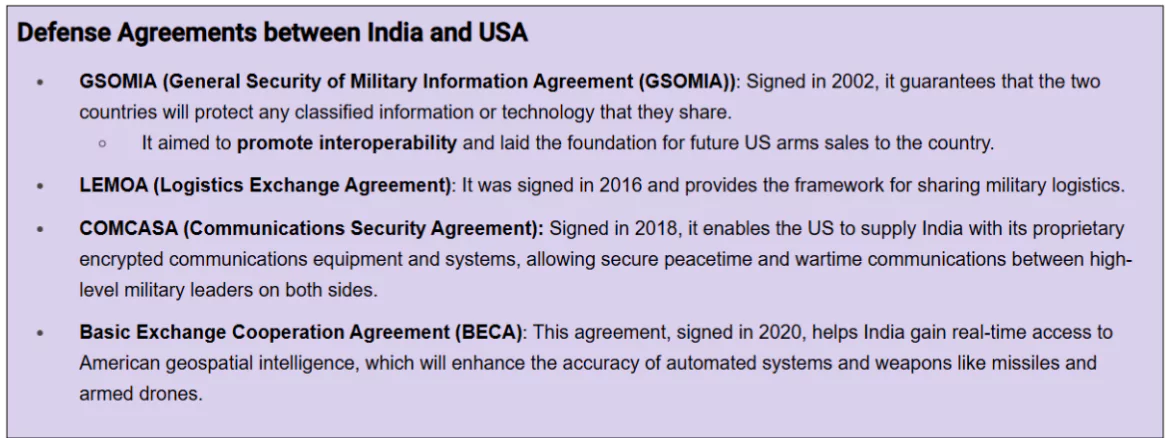Deepening the ongoing cooperation over the Indian Ocean Region, India and the U.S. are set to hold the inaugural India-US Indian Ocean Dialogue.
About the India-US Indian Ocean Dialogue
- Historical Context: The roots of India-U.S. collaboration in the Indo-Pacific can be traced back to 2015, when President Barack Obama and Prime Minister Narendra Modi released the Joint Strategic Vision for the Asia-Pacific and Indian Ocean Region, laying a foundation for regional security and economic initiatives.
- Objective: The primary goal of the dialogue is to discuss and promote measures that enhance security and economic prosperity across the Indo-Pacific.
- This collaborative approach addresses regional concerns such as maritime security, regional stability, and economic development.
- Key Participants: U.S. Deputy Secretary of State and Principal Deputy National Security Adviser will take part virtually.
- Technological Cooperation: Parallel to the dialogue, the iCET Intersessional meeting on Critical and Emerging Technologies is scheduled.
- Recent Political Context: The dialogue takes place in the wake of the U.S. presidential election, with former President Donald Trump winning the election. As the transition progresses, both nations remain committed to enhancing their partnership, particularly in the Indo-Pacific.
Enroll now for UPSC Online Course
About Indian Ocean Dialogue
- The Indian Ocean Dialogue, organised by the Indian Ocean Rim Association (IORA), serves as a key platform for discussing regional security, economic growth, and cooperation across various sectors in the Indian Ocean Region.
- Origin: The Indian Ocean Dialogue was established following the 13th Council of Ministers Meeting in 2013 in Perth, Australia, underscoring the importance of regional collaboration for shared growth.
- Inaugural session: The first of the Indian Ocean Dialogue took place in Kerala, India, in 2014, focusing on various areas of cooperation, including maritime safety, disaster relief, and economic partnership.
- Areas of Discussion: Key areas discussed in the Indian Ocean Dialogue include economic cooperation, maritime safety, blue economy, and disaster response, which aim to address regional challenges and promote sustainable growth.
About Indian Ocean Rim Association (IORA)
- Origin: The Indian Ocean Rim Association is an intergovernmental organisation established in 1997.
- Members: It includes 23 member states and 11 dialogue partners, working collaboratively to foster regional cooperation and development.
- Asia: India, Bangladesh, Indonesia, Iran, Malaysia, Maldives, Oman, Singapore, Sri Lanka, Thailand, United Arab Emirates, and Yemen.
- Africa: Kenya, Madagascar, Mozambique, Somalia, South Africa, Tanzania, Comoros, Mauritius, Seychelles.
- Oceania: Australia.
- Europe: France.
- Dialogue Partners: China, Egypt, Saudi Arabia, Germany, Italy, Japan, Republic of Korea, Russia, Türkiye, United Kingdom, and United States of America.
- Secretariat: IORA’s secretariat is based in Ebène, Mauritius, serving as the administrative hub for the organisation’s activities and regional engagements.
Administration: The Council of Foreign Ministers, IORA’s highest decision-making body, convenes annually to review progress and set future goals for regional cooperation.
India-US Cooperations
- Defence Cooperation
- Key Agreements: Foundational agreements like LEMOA, COMCASA, and BECA enhance military interoperability and secure communication channels between India and the U.S.
- Defense Trade: Key defence acquisitions include MQ-9B SeaGuardian drones and the co-production of GE F414 jet engines.

- Economic Engagement
- Trade: The United States is India’s second-largest trading partner, with bilateral trade exceeding $191 billion in 2022.
FDI: The U.S. invested $6.04 billion in India in the fiscal year 2022-23, strengthening economic ties.
- Strategic Partnerships
- Multilateral Ties: India and the U.S. collaborate within frameworks like the Quad and I2U2. The U.S. also supports India’s bid for permanent membership in the United Nations Security Council (UNSC).
- Clean Energy: Initiatives such as the Strategic Clean Energy Partnership (SCEP) and Climate Agenda 2030 encourage cooperation in renewable energy and critical mineral resources.
- Education Exchanges: Programs like the Fulbright-Nehru Program and GIAN foster educational exchanges and research partnerships.
- Cultural Property Agreement (2024): The 2024 agreement on cultural property safeguards Indian antiquities against illicit trafficking.
- Diaspora Ties: The Indian-American community, with a population of over 4.4 million, contributes to deepening cultural and academic ties between the two countries, strengthening the people-to-people link.
Check Out UPSC CSE Books From PW Store
About Initiative on Critical and Emerging Technologies (iCET)
- Purpose : The iCET serves as a cornerstone for India-U.S. cooperation in high-tech and emerging fields.
- The primary aim of iCET is to build strategic collaboration in critical technologies, focusing on co-development, supply chain resilience, and fostering robust technological partnerships between the two nations.
Key Focus Areas Under iCET
- Establishing Common AI Standards: iCET seeks to develop and align artificial intelligence (AI) standards, enabling interoperability and ethical AI practices.
- This alignment aims to ensure that AI systems are developed in line with shared democratic values and reliable safety standards.
- Enhancing Defense Tech and Linking Startups: In defence, iCET focuses on advancing joint development and enhancing defence technology partnerships.
- It also seeks to bridge Indian and U.S. defence startups, enabling innovation and cooperation across defence sectors.
- Building a Semiconductor Ecosystem: Recognizing the strategic importance of semiconductor technology, iCET supports initiatives to establish a resilient semiconductor ecosystem.
- This collaboration includes fostering chip manufacturing capabilities, supply chain diversification, and securing critical semiconductor components.
- Strengthening Human Spaceflight Cooperation: iCET emphasises expanding human spaceflight cooperation.
- This includes collaboration in satellite technology, planetary exploration, and supporting India’s space program as it advances human spaceflight initiatives.
- Advancing 5G/6G Development and OpenRAN Technology: iCET focuses on advancing telecom infrastructure with special attention to the next generation of telecommunications, including 5G and 6G technology.
- Collaborative work on Open Radio Access Network (OpenRAN) technology aims to create secure, flexible, and cost-effective network solutions.
- Expansion Of iCET: While iCET began as a bilateral initiative within the QUAD framework, there are strategic plans to extend this technological partnership to NATO and European allies, as well as to other global partners, thereby creating a wider network of tech cooperation based on shared principles and standards.
Additional Reading: Indian Ocean Region
To get PDF version, Please click on "Print PDF" button.


